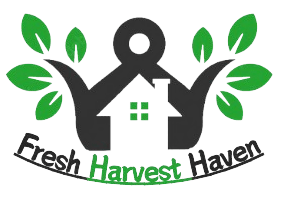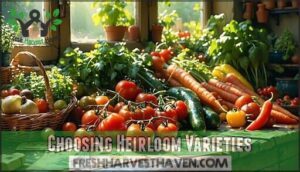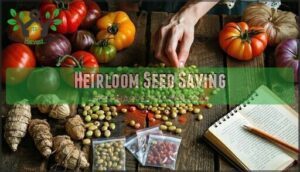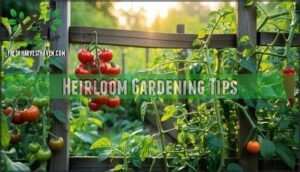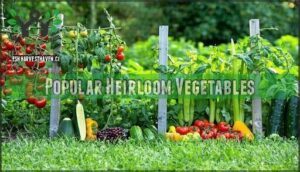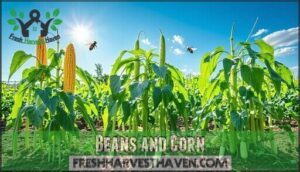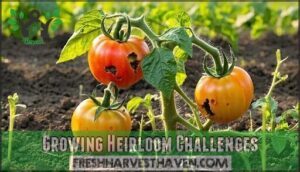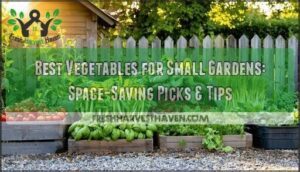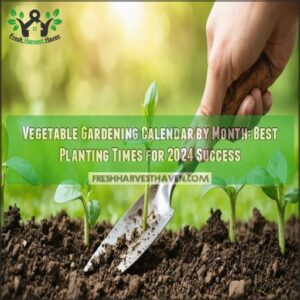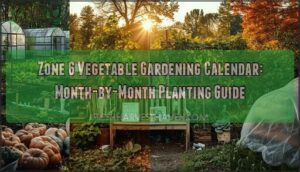This site is supported by our readers. We may earn a commission, at no cost to you, if you purchase through links.
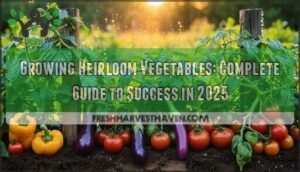
These veggies offer unique flavors, vibrant colors, and traits that connect you to gardeners from decades ago.
To help them thrive, you’ll want loose, rich soil, steady watering, and a watchful eye for quirky pests.
Choose varieties that fit your climate and space.
Growing heirloom vegetables means saving seeds, keeping traditions alive, and sometimes outsmarting a stubborn caterpillar or two.
The real secret? There’s magic in every bite, and each plant packs a lesson for tomorrow’s gardener.
Table Of Contents
- Key Takeaways
- Heirloom Vegetable Basics
- Choosing Heirloom Varieties
- Growing Heirloom Vegetables
- Heirloom Seed Saving
- Heirloom Gardening Tips
- Heirloom Vegetable Care
- Popular Heirloom Vegetables
- Heirloom Vegetable Nutrition
- Growing Heirloom Challenges
- Heirloom Garden Planning
- Frequently Asked Questions (FAQs)
- Are heirloom vegetables harder to grow?
- What is the secret to growing heirloom tomatoes?
- What is the difference between heirloom and heritage vegetables?
- How to grow heirloom vegetables?
- What makes a vegetable an heirloom?
- How do I know if my seeds are still viable?
- Whats the best way to deal with pests?
- Can I grow heirlooms in containers?
- When is the best time to water my garden?
- How do I stop my plants from cross-pollinating?
- Conclusion
Key Takeaways
- Choose climate-matched varieties – You’ll get better yields by selecting heirloom varieties that have adapted to your local growing conditions, frost dates, and temperature ranges rather than fighting against nature.
- Save seeds from your healthiest plants – You can preserve unique traits and flavors for future seasons by properly harvesting, drying, and storing seeds from your most vigorous, disease-free specimens.
- Focus on soil health and consistent care – You’ll see stronger plants when you provide loose, rich soil with regular organic amendments, deep watering, and steady monitoring for pests and diseases.
- Plan for space and support needs – You should research each variety’s growth habits before planting, as some heirlooms need more room to spread or stronger staking than modern hybrids.
Heirloom Vegetable Basics
Heirloom vegetables come from seeds passed down through generations, maintaining their original traits without genetic modification or hybridization.
Heirloom vegetables connect us to the past, carrying time-honored flavors from generations of dedicated gardeners.
You’ll discover these time-tested varieties offer superior flavors, diverse characteristics, and the rewarding ability to save seeds for future plantings, which includes the benefit of future plantings.
Definition and History
Heirloom vegetables are open-pollinated varieties passed down through generations, maintaining their original characteristics through natural seed lineage.
These heritage crops predate modern hybridization, preserving genetic diversity that commercial farming often overlooks.
Their historical significance lies in variety preservation—each seed carries stories of families, regions, and cultures.
Unlike hybrids, heirlooms grow true-to-type, producing plants identical to their parents when you save seeds properly, which helps in variety preservation and maintains the original traits of the heirloom vegetables.
Benefits of Heirloom Vegetables
Why choose heirloom vegetables over modern varieties?
You’ll discover unique flavors that commercial produce simply can’t match.
These treasured plants offer superior nutritional density, often containing higher levels of vitamins and minerals.
By growing heirloom varieties, you’re supporting biodiversity and genetic preservation while connecting with culinary heritage passed down through generations of gardeners.
Comparison to Hybrid Vegetables
Understanding the differences between these vegetable varieties helps you make informed garden choices.
Hybrid vegetables consistently deliver 15–30% higher yields and uniform ripening, making them perfect for large harvests.
However, heirloom vegetables shine with superior flavor profiles and genetic diversity that hybrids can’t match.
- Genetic Diversity: Heirloom vegetables maintain over 40 genetic traits versus hybrids’ narrower gene pool
- Flavor Profiles: Chef surveys rank 67% of heirloom vegetables superior for taste and aroma
- Seed Saving: Heirloom seeds reproduce true-to-type while hybrid seeds don’t breed reliably
- Disease Resistance: Hybrids offer engineered protection, heirlooms provide historic regional resistances
Choosing Heirloom Varieties
Selecting the right heirloom varieties sets the foundation for your garden’s success, as each variety has unique needs and characteristics that must match your growing conditions.
You’ll need to take into account your local climate, available space, and how much time you can dedicate to maintenance when choosing from hundreds of fascinating heirloom options.
Popular Heirloom Vegetable Types
Gardeners treasure certain vegetable varieties that have stood the test of time.
These champion plants offer unique flavors and characteristics you won’t find in modern hybrids.
From Cherokee Purple tomatoes with their smoky taste to rattlesnake pole beans with striking purple streaks, each variety tells a story.
| Vegetable Type | Popular Heirloom Varieties |
|---|---|
| Tomato varieties | Brandywine, Cherokee Purple, Yellow Pear, Amish Paste |
| Bean varieties | Cherokee Trail of Tears, Jackson Wonder Bush, Provider |
| Pepper varieties | Jimmy Nardello Sweet, Fish Hot, California Wonder Bell |
| Cucumber varieties | Lemon, White Wonder, Boston Pickling, Ashley |
These heirloom vegetables and heirloom seeds connect you to gardening traditions spanning generations.
Each variety offers distinct advantages – some resist cracking, others tolerate heat, and many produce exceptional yields when grown in proper conditions.
Selecting Varieties for Climate
Success in heirloom gardening hinges on mastering regional adaptation. Climate-specific varieties thrive because they’ve evolved alongside local conditions, while mismatched selections struggle against nature’s rhythm.
Understanding your garden zone transforms disappointment into abundant harvests.
Essential Climate Considerations:
- Frost Tolerance – Cold-hardy varieties like ‘Lacinato’ kale withstand temperatures to -6°C, while warm-season heirlooms need consistent soil temperatures above 18°C
- Heat Resistance – Drought-tolerant selections such as ‘Amish Paste’ tomatoes require 40% less water, and heat-adapted peppers handle summer peaks up to 35°C
- Growing Season Length – Short-season varieties mature in 60-70 days for brief summers, while long-season heirlooms need 90-100 frost-free days
Microclimates matter too. Your backyard’s unique conditions – wind patterns, sun exposure, and elevation – create distinct growing environments.
Temperature-sensitive varieties show 25% higher disease rates when grown outside their comfort zones, while properly matched heirloom vegetables demonstrate 60% higher yields than non-adapted types.
Considering Space and Growth Habits
Your garden space shapes which plant varieties thrive best.
Vertical gardening maximizes small areas, while sprawling varieties like Moon and Stars watermelon need room to spread.
Check sunlight requirements and root depth needs when planning garden beds.
Container options work well for compact plants, but consider plant spacing for proper growth and air circulation in vegetable gardening.
Consider also the climate’s hardiness zones to guarantee plant survival.
This includes understanding the specific needs of each plant variety and the overall garden space.
Growing Heirloom Vegetables
Growing heirloom vegetables successfully requires understanding their unique needs and characteristics compared to modern hybrids.
You’ll need to master soil preparation, provide ideal growing conditions, and develop effective pest and disease management strategies to help these time-tested varieties thrive in your garden, which includes mastering the art of growing conditions.
Preparing Soil and Sowing Seeds
Most successful heirloom gardens start with proper soil testing to determine pH and nutrient levels.
You’ll want to incorporate soil amendments like compost or aged manure several weeks before sowing. Knowing your soil composition is key, and you can achieve this with a reliable testing solution.
For seed starting indoors, use sterile potting mix and maintain consistent moisture for ideal germination rates. Direct sowing works well for beans and radishes, while tomatoes benefit from indoor seed starting to extend growing seasons and improve seed viability.
Providing Optimal Growing Conditions
Optimizing growing conditions transforms your heirloom garden into a productive paradise.
Provide six to eight hours of direct sunlight for heirloom tomatoes and most vegetables. Maintain consistent soil moisture through deep, infrequent watering techniques rather than daily sprinkles.
Apply organic fertilizer monthly to support robust soil health. Consider using suitable garden fertilizer for superior results.
Monitor temperature control using row covers during unexpected cold snaps to protect tender seedlings from stress.
Managing Pests and Diseases
When heirloom vegetables face pest invasions, you’ll need strategic defenses beyond just hoping for the best.
Implement crop rotation and companion planting with marigolds to boost disease resistance naturally. Monitor regularly for plant pests and diseases, using organic pesticides sparingly.
Focus on soil health through compost additions, as healthy plants resist problems better. Apply fungicide only when necessary for disease prevention.
Many gardeners choose heirlooms for their natural pest resistance, which is a key factor in their disease resistance and ability to thrive with organic pesticides.
Heirloom Seed Saving
When you save seeds from your healthiest heirloom plants, you’re preserving unique traits and flavors for future gardens.
It’s a simple process, but you’ll need to pay attention to proper harvesting, drying, and storage so your seeds don’t turn into a science experiment gone wrong.
Importance of Seed Saving
Just like tending your plants, caring for heirloom seed lines connects you to something bigger.
Nurturing heirloom seeds links you to generations of gardeners and nature’s timeless legacy.
Saving open-pollinated seeds doesn’t just boost your own seed viability—it backs genetic diversity and seed diversity for everyone.
Passing seeds down means preserving flavor, adapting to local conditions, and keeping communities resilient.
Plus, you never know when that extra squash gene will save the day and support seed viability!
Techniques for Saving Seeds
From pollination methods to seed cleaning, each step sharpens your seed saving skills.
Use the fermentation process for wet seeds like tomatoes, while beans deserve proper drying techniques.
Label seeds as you go, and test viability with a simple sprouting check.
Proper airflow is essential, so consider using specialized drying equipment for reliable seed storage—don’t rush the seed drying.
Storing and Preserving Seeds
Once you’ve mastered the seed saving and drying methods, keeping those seeds viable is the next step.
Proper seed storage means cool, dry spaces and airtight containers. Don’t forget to label everything—memory’s a fickle friend!
Use these tips for success:
- Dry seeds thoroughly
- Use airtight storage containers
- Label with variety and date
- Store in cool, dark places
- Guard against pests
Heirloom Gardening Tips
You’ll get the best results from heirloom vegetables when you rotate crops, pair plants wisely, and watch for common issues.
Don’t worry if your tomatoes grow taller than your neighbor’s fence—supporting healthy growth is part of the fun, and it’s about watching for common issues that may arise.
Crop Rotation and Companion Planting
Once you’ve saved seeds, it’s time to boost your vegetable garden with crop rotation and companion planting.
Rotation benefits include fewer soil diseases and happier plants.
Try companion combinations—like basil with tomatoes—for natural pest control and flavor.
Mixing beans with corn improves soil health and yield improvement.
These organic gardening tips keep your soil thriving and your harvests coming, utilizing methods like companion planting for natural benefits.
Supporting Plant Growth and Health
After sorting out crop rotation and companion planting, focus on supporting plant growth and health.
Keep your soil lively with regular soil amendments, and don’t skimp on watering techniques—plants hate soggy feet!
Stay sharp with pest control and disease prevention.
Good nutrient management helps avoid plant stress, while steady plant care and pollination keep those heirloom veggies thriving season after season.
Troubleshooting Common Issues
After boosting plant health, you might spot gardening challenges like stunted growth, blossom drop, or cracking fruit.
Don’t panic—heirloom vegetables are tough, but they need your watchful eye.
Practice pest identification and pest management early, and use disease control methods for plant diseases.
Catch issues fast, and your garden won’t turn into a bug buffet or wilted salad bar.
Heirloom Vegetable Care
You’ll need to master watering, feeding, pruning, and pest control to keep your heirloom vegetables healthy and productive.
Don’t be surprised if your tomatoes demand more attention than your family pet—they thrive with careful, consistent care.
Watering and Feeding
Most heirloom vegetables thrive with regular watering, but watch the soil—too much water can drown roots.
Check for nutrient deficiencies, especially in older soils. Feed plants with balanced fertilizer types or compost tea for nutrient-rich produce.
Don’t forget to adjust your watering frequency as temperatures change. For ideal results, consider watering early in the morning to minimize evaporation.
Good soil nutrients and regular fertilizing keep your heirlooms happy, healthy, and productive.
Pruning and Training
Three essential steps help you master pruning and training heirloom vegetables:
- Pinch tomato suckers to focus energy on main stems.
- Use cucumber trellising and bean supports for upright growth, saving space and boosting airflow.
- Prune pepper branches and thin corn for stronger plants.
Staking and trellising keep plant leaves healthy, while careful plant pruning prevents overcrowding and disease.
Pest and Disease Management
Spotting trouble early is half the battle in pest control. Use weekly checks for pest identification, and don’t be shy about handpicking hornworms.
Organic solutions like neem oil and yellow sticky traps help with insect harboring. Try companion planting with marigolds for natural predators.
Choose disease-resistant varieties for smarter disease management and keep mulch handy to limit disease harboring.
Popular Heirloom Vegetables
You’ll find that heirloom tomatoes, peppers, cucumbers, squash, beans, and corn each bring unique flavors, colors, and growth habits to your garden.
It’s easy to get excited when you realize some beans can climb faster than your dog chasing a squirrel, while tomatoes like ‘Brandywine’ need sturdy support to thrive, and exhibit unique growth habits.
Tomatoes and Peppers
Your garden’s tomato varieties and pepper varieties will wow with vibrant flavor profiles and unique growing techniques.
Try these heirloom favorites:
- ‘Brandywine’—classic, rich taste, indeterminate growth.
- ‘Cherokee Purple’—smoky, crack-resistant.
- ‘Jimmy Nardello’—sweet, glossy peppers.
- ‘Fish’—striped, spicy, ornamental.
- ‘California Wonder’—thick-walled, perfect for culinary uses.
Cucumbers and Squash
If tomatoes and peppers keep you guessing, cucumber varieties and squash varieties bring their own surprises.
Lemon Cucumber and White Wonder offer crisp, quirky shapes, while Black Beauty squash and Luffa Sponges add texture and fun.
Speckled Swan gourds look like garden art.
Seed saving with heirloom cucumbers and heirloom squash keeps your harvest flavorful and your garden unique.
| Variety | Shape |
|---|---|
| Lemon Cucumber | Round, yellow |
| White Wonder | Ivory, oval |
| Black Beauty | Dark, oblong |
| Luffa Sponges | Long, fibrous |
| Speckled Swan | Swan-shaped |
Beans and Corn
Now that you’ve got cucumbers and squash covered, let’s talk beans and corn.
Bean pollination happens best with a gentle breeze or a helping bee. You’ll want bean support for climbing varieties.
Heirloom beans like ‘Cherokee Trail of Tears’ shine in Three Sisters gardens.
Corn sweetness depends on your chosen corn varieties—openpollinated heirloom corn delivers flavor and resilience.
Heirloom Vegetable Nutrition
You’ll find that heirloom vegetables pack plenty of vitamins, minerals, and antioxidants, often with richer flavors than store-bought hybrids.
If you’ve ever wondered why your garden carrots taste sweeter, it’s not magic—it’s science and a bit of old-fashioned variety.
Nutritional Benefits
Once you’ve picked your favorite heirloom vegetables, you’ll notice their nutrient-rich produce stands out.
These beauties pack more punch in every bite, offering:
- Higher vitamin content—think vitamin C and A.
- Mineral richness, like iron and magnesium.
- Fiber density for gut health.
- Phytonutrient diversity, boosting Antioxidant Properties and crop diversity for unique vegetable flavors in your vegetable recipes.
Diets rich in vegetables can reduce diabetes risk substantially, which is a key benefit of consuming a variety of vegetables with high Antioxidant Properties.
Health Benefits of Heirloom Vegetables
You’ll notice heirloom vegetables offer robust Nutrient Density, supporting Disease Prevention and Gut Health.
Their Antioxidant Power stands out, thanks to diverse vegetable flavors and crop diversity.
You get nutrient-rich produce and unique flavor profiles, making every garden-to-table meal a treat.
Flavor preservation also means you’re eating food as nature intended—no bland, mass-produced bites here.
| Nutrient Density | Antioxidant Power | Gut Health |
|---|---|---|
| High vitamins | Rich pigments | Fiber-rich |
| Mineral content | Disease defense | Prebiotic effect |
| Crop diversity | Flavor profiles | Supports flora |
| Flavor profiles | Immune boost | Easy digestion |
| Disease prevention | Natural enzymes | Balanced nutrition |
Growing Heirloom Challenges
You’ll face a few unique challenges when growing heirloom vegetables, from unpredictable yields to stubborn pests.
Don’t worry, with careful planning and a bit of patience, you can keep your garden thriving and avoid most surprises, ensuring that your garden remains healthy with complete concepts of gardening in mind.
Common Challenges
While heirloom vegetables pack a nutritional punch, you’ll run into common headaches like pest susceptibility, weak plant disease resistance, and unpredictable seed viability.
Variable yields can leave you scratching your head, especially when climate adaptation is tricky.
Garden pests love heirlooms, and drought tolerance isn’t always great.
Seed availability and changing heirloom seed laws can also complicate your growing plans.
Solutions to Common Problems
If weeds are taking over, try mulching to boost soil health and block them out.
For watering issues, stick a finger in the soil—if it’s dry, give plants a drink.
Keep diseased plants out and practice plant sanitation for better plant disease resistance.
Pest control matters, so invite ladybugs. Use strong heirloom tomato varieties for improved seed germination and disease resistance.
Tips for Success
After tackling problems, you’ll want to stack the odds in your favor.
Focus on these strategies for a thriving heirloom garden:
- Test and amend soil for proper Soil Preparation
- Start seeds indoors for better Seed Starting success
- Use consistent Watering Techniques, not guesswork
- Monitor for pests and use smart Pest Control
- Match heirloom tomato varieties, beets, broccoli, and cabbage to your Climate Considerations, ensuring a well-planned Soil Preparation and effective Pest Control.
Heirloom Garden Planning
You’ll want to plan your heirloom garden with careful attention to each variety’s needs, growth habits, and space requirements.
It’s a bit like arranging a family reunion—everyone needs their own seat, and some guests might spread out more than others.
Planning and Designing
Once you’ve tackled tough growing seasons, it’s time to channel that grit into garden planning. Sketch your garden layout, weigh climate considerations, and assess your space management.
Review seed catalogs for heirloom vegetables with unique growth habits. Map out where each crop fits best.
Good garden design blends creativity with science—and sometimes, a dash of luck.
| Garden Planning Step | Quick Tip |
|---|---|
| Garden Layout | Draw a simple map first |
| Variety Selection | Match to climate and space |
| Space Management | Group by plant height & spread |
| Growth Habits | Note indeterminate vs. bush type |
| Seed Sourcing | Try local or trusted seed catalogs |
Choosing The Right Varieties
Once your plan’s mapped, it’s time to pick what fits.
Think about climate considerations—some regional varieties thrive where others wilt. If your garden’s tight on space, compact types work wonders.
Scout for disease resistance, bold flavor profiles, and family favorites. Choose seed sources that support seed preservation.
Heirloom vegetables adapt best when you line up space limitations with smart seed sourcing. Consider the local hardiness zones to guarantee the best growth.
Creating a Heirloom Garden Layout
Once you’ve chosen your heirloom vegetables, it’s time to sketch your garden layout.
Map sunlight patterns to spot the best planting zones. Use companion planting for garden diversity and healthier crops.
Try vertical gardening for space optimization—your beans will thank you! Mix in aesthetical design for curb appeal.
Good planning means easier seed saving and happier plants, which is the result of careful consideration and effective planning.
Frequently Asked Questions (FAQs)
Are heirloom vegetables harder to grow?
Funny thing—heirloom vegetables aren’t actually fussier than modern ones.
They just like steady care: good soil, sunlight, and a watchful eye for pests.
If you’re patient and stay curious, you’ll find them surprisingly rewarding.
What is the secret to growing heirloom tomatoes?
Give ’em sunlight, rich soil, and steady moisture; stake the vines—they get rowdy.
Pinch off low leaves for better airflow.
Save seeds from the healthiest fruits. Don’t rush—heirloom tomatoes reward patience with flavors store-bought can’t touch, offering unparalleled taste.
What is the difference between heirloom and heritage vegetables?
Think of heirloom vegetables as old family recipes, passed down unchanged—open-pollinated and true to type.
Heritage vegetables, while also traditional, can include regional or cultural favorites, sometimes with subtle twists or adaptations over generations.
How to grow heirloom vegetables?
Start seeds indoors, then plant seedlings in rich, loose soil after frost.
Give plenty of sun and space.
Water deeply but let soil dry out between soakings.
Save seeds from the healthiest plants for next year’s garden magic.
What makes a vegetable an heirloom?
Picture treasures passed from hand to hand—heirloom vegetables are just that in your garden.
They’re open-pollinated, non-hybrid plants with a backstory, grown true from seed, each one a living memory you can taste.
How do I know if my seeds are still viable?
To check seed viability, drop a few in a damp paper towel, fold it up, and seal in a plastic bag.
Wait a week.
If most sprout, your seeds are ready for action—no crystal ball required!
Whats the best way to deal with pests?
Did you know up to 40% of harvest loss comes from pest damage?
You’ll outsmart them by rotating crops, encouraging helpful bugs like ladybugs, using row covers, and handpicking troublemakers.
Patience and sharp eyes win the battle.
Can I grow heirlooms in containers?
You absolutely can grow heirlooms in containers—just pick a pot at least 5 gallons.
Use quality soil, give them plenty of sun, and don’t be shy about staking vigorous types.
Water deeply, not just a sprinkle.
When is the best time to water my garden?
Early morning’s gentle embrace offers your plants the perfect drink.
Water between 6-8 AM when temperatures are cool and winds are calm.
This timing allows roots to absorb moisture before heat stress begins, preventing fungal diseases that thrive in evening dampness, which is a critical factor in maintaining plant health through proper moisture management.
How do I stop my plants from cross-pollinating?
Separate plants by 100+ feet or use physical barriers like row covers. Time plantings so varieties flower at different periods. Hand-pollinate specific plants and bag flowers immediately afterward.
Conclusion
Success with growing heirloom vegetables boils down to this timeless truth: "Good things come to those who wait".
Your patience and dedication to these heritage varieties will reward you with flavors that store-bought produce can’t match.
Remember to save seeds, rotate crops, and celebrate those quirky imperfections that make heirlooms special.
You’ve got the knowledge—now let your garden tell its own delicious story through generations of proven genetics.
- https://www.gardeningknowhow.com/edible/vegetables/vgen/heirloom-vegetables.htm
- https://www.burpee.com/blog/top-tips-for-growing-heirloom-vegetables.html
- https://thehouseandhomestead.com/heirloom-vegetable-garden/
- https://www.theprairiehomestead.com/2022/02/why-you-should-grow-heirloom-seeds.html
- https://hgic.clemson.edu/factsheet/heirloom-vegetables/
